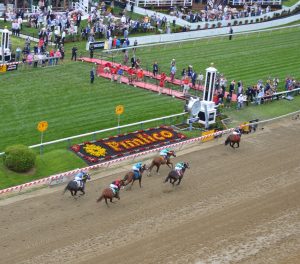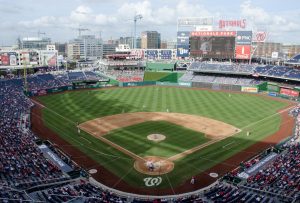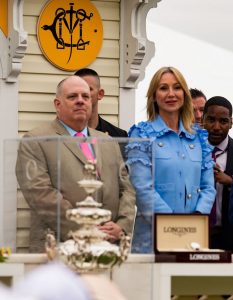Belinda Stronach: State aid would be needed to keep Preakness at Pimlico
What is the future of horse racing in Maryland, specifically as it pertains to keeping the Preakness at Pimlico? With the 142nd running of the Preakness now in the books, racing fans wonder how much longer the renowned event will remain at the aging edifice affectionately know as Old Hilltop. Marylander’s are particularly concerned about the cost of building an expensive new facility on a parcel which is partly bordered by a blighted community, while Baltimoreans weigh the certain loss of revenue and the hit on civic pride the city would take should the track close and the illustrious race move to Laurel, Maryland. The Baltimore Post-Examiner raised these issues with Belinda Stronach a few hours before the trumpet call of this year’s Preakness. Belinda Stronach is Chairman of the Stronach Group: the international gaming company which owns both Pimlico and Laurel racetracks.
BPE: Thank you for taking some time to chat with us on such a busy day. Your family has a long history in the horse racing industry. Could you speak a bit about that history and where you see the industry going?
Stronach: My father has been in the horse racing industry for over fifty years When I was young, we’d go to the track and have a hot dog and a coke, so I grew up in and around the horse racing business. My father has always been very passionate it. As time moved on, and he was no longer just a horse owner and breeder, he saw the opportunity to acquire some of the key racing properties. He realized looking forward that both the tracks and the experience needed to be modernized.

To backtrack just a bit, most of my early career was in the automotive world, as well as a short term in politics. I came out of that around the time my family was able to fully acquire the racing properties. It’s more in the last two years that I have played a very active role in the Stronach Group Racing Company. It is my belief that horse racing is the last great legacy sporting platform that has not really yet modernized. When I talk about that, I mean everything about the on-track experience, providing the customer with a broad spectrum of food, style and service options. In addition to that, we have to invest in technology. To make it much more accessible and understandable for people to wager. We’re looking at aspects such as the gamification of horse racing. Gaming is fun, it makes the sport accessible, people can learn how to bet and at the same time creates more horse racing fans.
BPE: I know we don’t have a crystal ball here, but do you think horse racing will ever get to the point where it’s a go-to event, like game day in the NFL?
Stronach: I think we have an amazing future ahead of us. When I look at some of the key properties that The Stronach Group owns, and where I see the potential of those properties and the kind of customer experience that we wish to offer, I think they can become super-fun on-track experiences. I think we have to do a much better job at showing people that horse racing can be fun. It’s an exciting two minutes, and not everybody has time to go to a 3- or 4-hour game these days. I think we have to capitalize on the fact that we are an exciting two minutes, and then make sure that we curate the experiences on-track, between races, so that it’s a great place to be. On the wagering side, we have to look at different types of wagers, different types of applications to make sure that we’re also catering to the person that is interested in betting.
BPE: One problem everyone seems to agree on is the need to attract a younger audience.
Stronach: Absolutely.
BPE: In the age of group selfies and limited attention spans, how do you plan to reach people who look more inward than out?

Stronach: I don’t have the numbers off the top of my head, but we have the highest growth rates in terms of social media following in the industry. And we are trying new things. For example, we launched a race earlier in 2017, called The Pegasus World Cup – a new marquee event that has very high prize money. That is the richest horse race in the world. It had a $12 million purse last year; $16 million this year. And in and around that, we see it as more than a horse race. It’s an event and an opportunity to engage a new generation of fans.
So, we try things.
For example, we asked Conor McGregor, the well-known MMA athlete, if he would be our spokesperson in these vignettes, called The Thirteenth Jockey. We had incredible success with that, in terms of media impressions, but they’re off the charts in terms of numbers. The key for us, once that awareness is created, is how to make those individuals – that younger generation of fans – as excited by horse racing on a daily basis. So it’s on track: they love experiences, they love curated experiences.
We’ve also learned that young people like games of skill and that it’s up to us to make sure that we are creating new apps that they can download on their I-Phone. That is another way to make thoroughbred racing more accessible to novice fans and not just geared towards the hard-core handicapper, which many of the current platforms are.
BPE: Research has shown that modern consumers are deeply concerned about social causes. A case in point may be this year’s closing of the Ringling Bros. Circus. The circus, as you know, had been under the microscope for years with concerns about the treatment of animals. How do you respond to those who have questions about the way horses are bred and treated?

Stronach: I’m glad people have concerns, and I have concerns as well. The Stronach Group was one of the founding partners of the Thoroughbred Aftercare Program. I think that is something that we have to look at; to reinvest much more to make sure that we address the entire value chain in terms of the horse’s life. We want to make sure that horses are treated in the most humane way possible and respected as equine athletes. That they’re competing in a safe and healthy environment. We have principles for no race-day medication, but we have to work together with the industry to make sure that we are all on the same page and that we can move forward as an industry in that direction. So the health of the animal, making sure that we support that, is top of mind for us. We’re very open to ideas and solutions as to how we can make that even better. But it is something we care deeply about. I personally care deeply about it.
BPE: For decades, people across the board have recognized the need for a modern facility at Pimlico. What were your thoughts when your family bought into Maryland racing?
Stronach: Well, I wasn’t active on a day-to-day basis from an operations standpoint, but I thought it was a good idea when my father bought into Maryland racing. I supported his strategy in terms of acquiring some properties on both the East Coast and West Coast – which includes Maryland, California, and Florida. I also supported his idea that those facilities presented a great opportunity but needed modernization. Having said that, coming back to Maryland, we are committed to being here in Maryland. We want to see that the industry is strengthened in whatever we do and will provide for a stronger, more sustainable industry. We are prepared and continue to make capital investments and have, on a per race-day basis, made equal investments actually in Laurel and Pimlico.
BPE: You’re telling us that you’ve made equal investments in Pimlico and Laurel?

Stronach: It’s actually equal, but it’s only 12 days here versus year-round in Laurel. So we wish to offer a certain level of customer experience in a state-of-the-art modern stadium. That requires a certain dollar amount. It’s very difficult to make that investment in two locations that are not too far away. Because Laurel is year-round, and we’ve put in a bid to host The Breeder’s Cup, obviously we are making investments in Laurel. There’s a lot of growth potential on those lands. Having said that, we also respect that there’s a lot of passion and history and tradition around Pimlico. But it’s something that we would wish or we would need, I should say, to work together with the state and with the city to see if it’s possible to have a state-of-the-art facility here with expansion possibilities. So it’s a work in progress. I think we’re very open-minded to what the best solution is, but it has to make economic sense, and it has to be good for the industry here.
BPE: Have any promises of help from the city been made – either explicitly or implied?
Stronach: From my understanding, through Tim Ritvo, our chief operating officer, the city is very supportive. They also understand we need to run a business, and it needs to be economically viable. As I understand it, they are very open to exploring different ideas, but the city cannot do it alone. It would require state involvement as well, and the governor will be joining us today, so maybe we’ll have a chance to touch base and to further those discussions. But we would need to have a partnership.
BPE: How has the state lived up to its commitments?
Stronach: We have a very good relationship with the governor’s office, with the state, and with the city. I think it’s very constructive. It’s not an easy thing though, you know. It’s a complicated situation and requires a lot of dollars. And even here at Pimlico, it’s not just the track and rebuilding it. It’s how can we expand? What about the surrounding infrastructure? We can have new pipes in the building, but what do we have to hook them up to? And is it sustainable? So, it’s a more wholistic situation or solution that needs to be explored. And certainly, just from an economic and industry standpoint, we are forging ahead to make those investments at Laurel. We see great possibilities there, but we’re really open-minded with respect to Pimlico and The Preakness. That’s where it should be.

BPE: You’ve expressed concerns about the neighborhood – particularly the crime around Pimlico. When the Washington Nationals Park was first proposed for Anacostia – a crime-riddled neighborhood in DC – a lot of people raised those exact same concerns. Yet today, less than a decade after the ballpark was opened, DC residents expect to see nearly 50% of the planned revitalization of the community completed in the next three years. Wouldn’t building a state of the art facility at Pimlico have the same effect on the surrounding community?
Stronach: I don’t know the answer to that. I would think that it would again have to be a wholistic approach. When we do our own internal analysis, we say, ‘Look. The Kentucky Derby – they have a stadium where each year they invest and they expand.’ We feel that The Preakness is as – if not more – exciting than The Kentucky Derby. We always like to say that the Kentucky Derby is the prep race for The Preakness because the best of the best move forward. And when you look at the demand that is there for The Kentucky Derby – the amount of suites that they have – and how Churchill continues to reinvest and expand; we feel we can do the same. So we need to look at the stadium here, and there’s a view we have in terms of what a stadium should look like. But it needs to be a more comprehensive plan; it has to be. So obviously safety, economic development, and infrastructure all has to go hand in hand. That’s where we would need to look at a partnership with the state and the city.
BPE: On the west side of Baltimore, in an area just south of Edmondson Village called the Uplands, developers completely razed a nearly 63-acre site and are now in the process of turning that area into a $238 million mixed-use residential community. Would you be in favor of something like that for the blighted areas surrounding Pimlico?
Stronach: I think we’d have to look at it. We’re open to all kinds of solutions that would make sense for the company and for the community here. We want to be good corporate citizens, and ultimately, we want to make sure that neighborhoods do become safer and people have economic opportunity. That they can seek good employment in locations in which they live and work. I think we’re very open-minded as a company. We haven’t concluded on any plans firmly for Pimlico. We’re open to something that is good for the company, good for the community, the city and the state. We plan to be here for a long time.

BPE: Gov. Hogan has said that while he wants to see the Preakness stay at Pimlico, the state will not be writing a check for $300 million. What percentage of the cost should taxpayers be asked to bear to rehabilitate or rebuild the track?
Stronach: It’s tough for the company to do that in two locations, when we have to compete for the same time, attention, and eyeballs as other sporting platforms – baseball, football, hockey, or just other forms of entertainment. The question is: Can we do that in two places by just purely funding it with internal resources? We would need partnerships to do it in two locations. It has to make sense. Whatever we do going forward, it is going to move racing forward in the state of Maryland. We would not do anything that wouldn’t be good for the racing community, because they are stakeholders in our business.
BPE: Moving forward, what would you like to see the City of Baltimore do?
Stronach: That’s a good question. We are in discussions. We have a good constructive relationship with the mayor, and we want to make sure that we look at things in a very logical way, realizing we can make a certain amount of investment, but we have to be joined by the city and the state for the race to continue at Pimlico. It’s just not the best place to hold a race at the moment. I mean, the energy of the people and the tradition is what makes it great right now. But we could do a much greater job if we had a building that could facilitate a greater experience. The people of Baltimore care a lot about the Preakness, you can feel the energy that is building, and people are excited. We appreciate that; and just having good honest relationships and solutions is what we are doing right now.
BPE: Are you prepared to pledge to the citizens of Baltimore that the Preakness will remain at Pimilco?
Stronach: I can’t do that at this stage. We are in the process of exploring the various options at both Laurel and Pimlico, and the existence of having two great racing facilities versus the one which would host the event. So, we’re not there yet. It’s a work in progress. We have some thoughts, but those are not set in stone. We are very open-minded.

Anthony C. Hayes is an actor, author, raconteur, rapscallion and bon vivant. A one-time newsboy for the Evening Sun and professional presence at the Washington Herald, Tony’s poetry, photography, humor, and prose have also been featured in Smile, Hon, You’re in Baltimore!, Destination Maryland, Magic Octopus Magazine, Los Angeles Post-Examiner, Voice of Baltimore, SmartCEO, Alvarez Fiction, and Tales of Blood and Roses. If you notice that his work has been purloined, please let him know. As the Good Book says, “Thou shalt not steal.”
